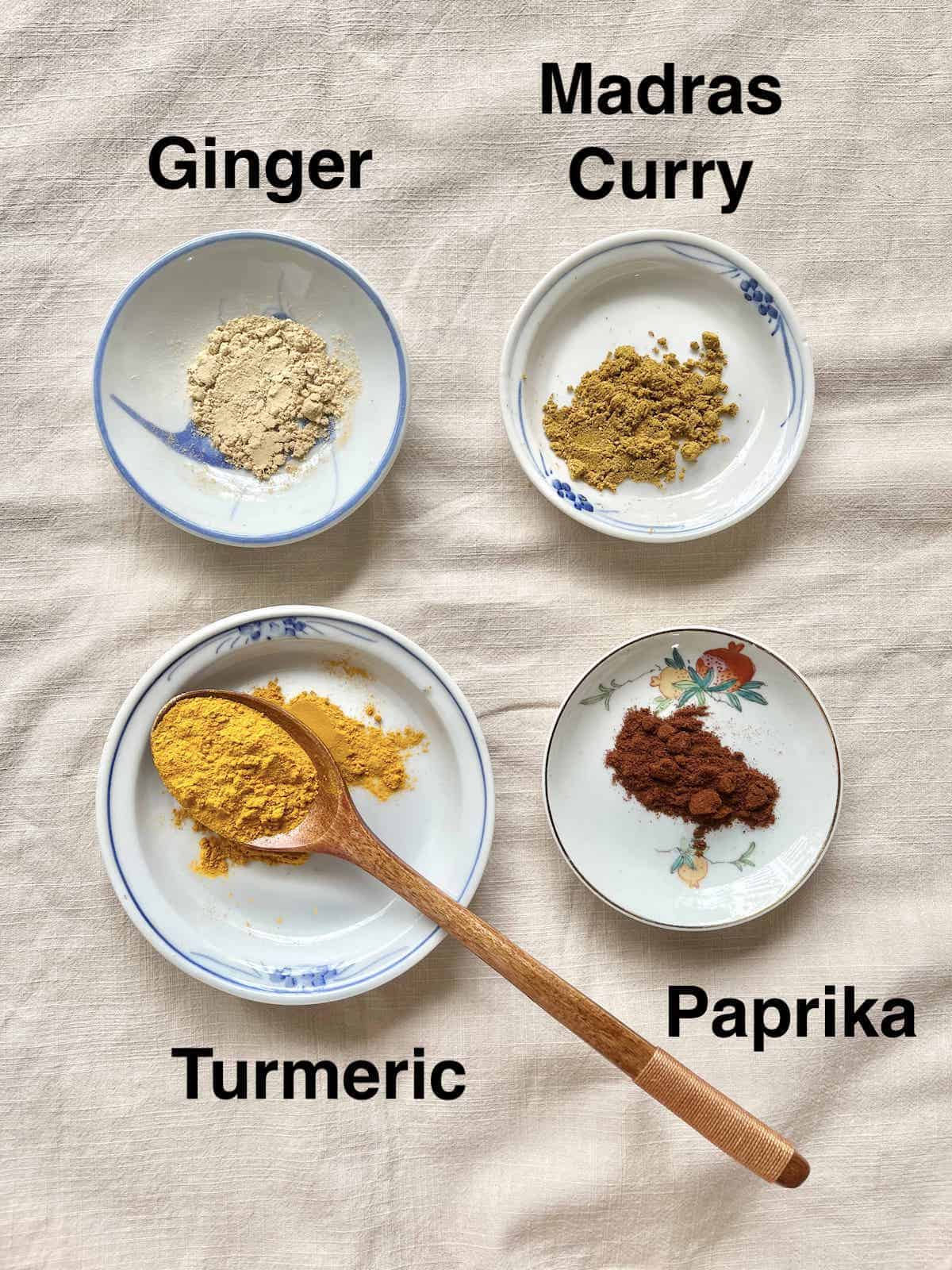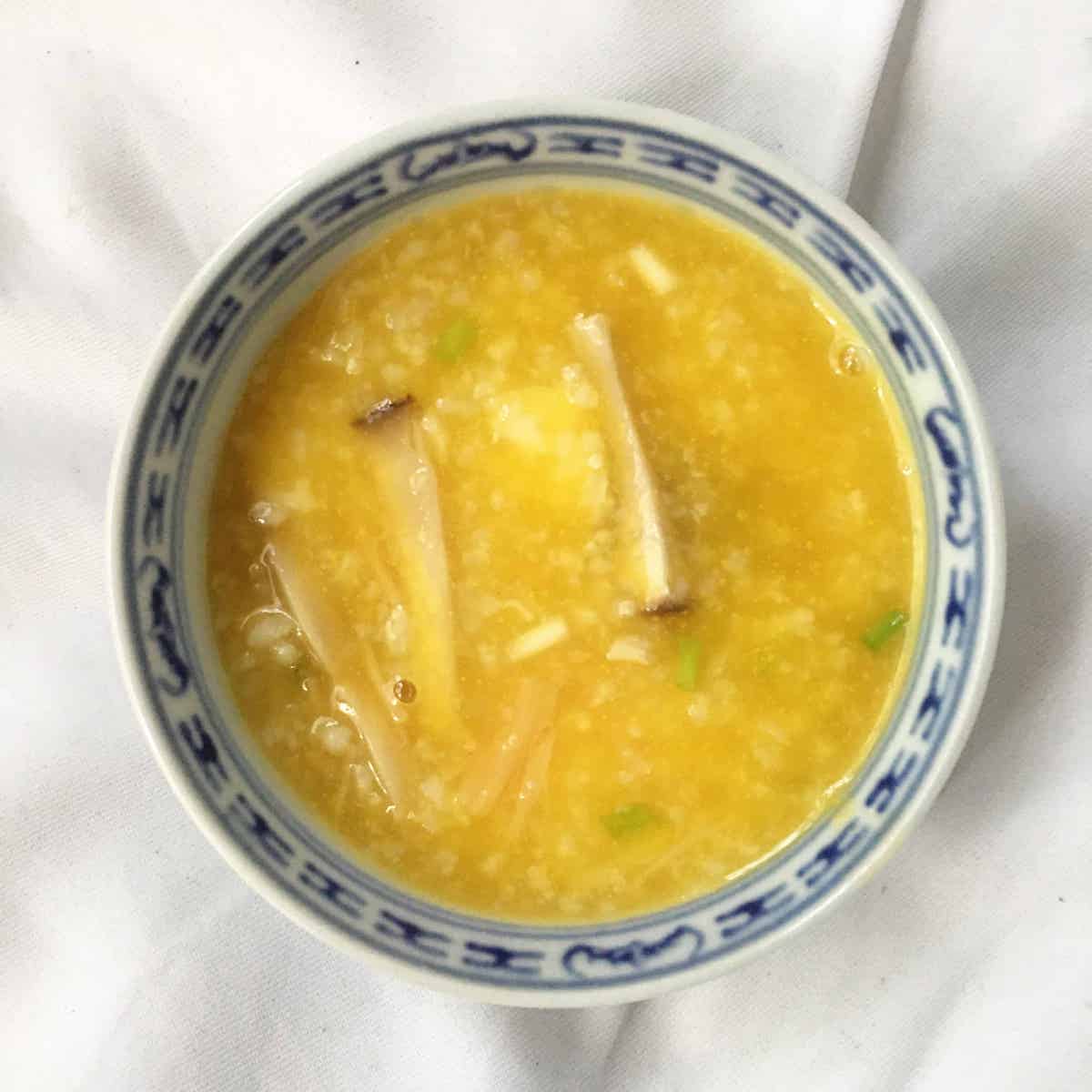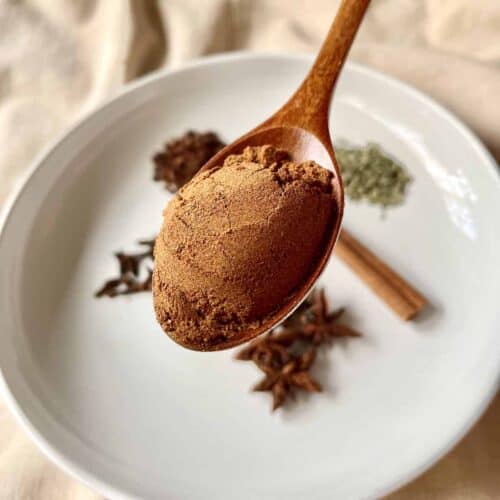A list of the 9 Best Substitutes for Turmeric, to replace both its beautiful golden colour and/ or its warm flavor.

Jump to:
What is Turmeric?
Turmeric, also known as Curcuma longa or kunyit, is a flowering rhizome. Like ginger, it has a bulb that grows underground, with green leaves that grow above the surface of the soil. Although the leaves are also edible, the word "turmeric" in cooking generally refers to the bulb root.
Turmeric root has a unique flavor and this spice powder is used in both traditional medicine as well as many South East Asian and Indian dishes such as turmeric rice, turmeric cinnamon tea and turmeric potatoes.
It's also found in Anglo-Indian recipes, such as some versions of Madras Curry Powder.
How to Use
Turmeric in its fresh form is usually sliced thinly or pounded into a orangish paste before using, or used in its dried powder form (in small amounts).
It is used in soups, dishes, desserts and drinks for 2 reasons:
- to add an earthy, almost peppery, flavor to various Asian breads or curries (e.g. Assam fish curry) and other dishes
- to give Asian dishes a vibrant color (e.g. golden Chai Tea (perfect for when you have Chai Tea Syrup on hand!), turmeric tea or these easy turmeric recipes such as turmeric rice. You only need to add a pinch to the rice cooker to get a beautiful yellow rice!)
Tip: the musky and almost bitter flavor of turmeric means it is best paired with sweeter spices such as cinnamon.
Fresh vs Dried vs Paste

You can use fresh, dried, frozen and turmeric paste interchangeably, as long as you pay attention to the quantities, as they have different concentrations.
The various forms actually make the best substitutes for each other but, if you can't get any of them, I have a list of other good substitutes for turmeric below.
As with most herbs, dried turmeric spice is more potent than fresh, as the water content has been removed. Thus, do remember to use 2-4x more if replacing dried turmeric with fresh. (If you can get fresh turmeric root, always use that, as preservation eliminates some of the original aromas.)
Pounding ½ inch of turmeric root = 1 (regular) teaspoon of turmeric paste = ½ teaspoon of turmeric powder
Note: there is also a commercial turmeric paste, in which turmeric has been mixed with other spices and oils. This is usually used in Indian drinks such as Golden Milk.
Health Benefits
IMPORTANT: I am not a medical professional. Do consult with a medical professional for more information, especially if pregnant, if you have gallbladder issues or are on chemotherapy or anti-clotting medication as turmeric may worsen the condition/ interfere with the treatment.
In Southeast Asia, the region turmeric root is native to, it is not just used in the kitchen but also in traditional medicine.
My Grandmother used to make us eat curry almost every day because it had turmeric which is good for you. (I love curry, but not every day! And yes, the herb may have health benefits but too much coconut cream isn't very healthy!)
Turmeric has a lot of nutrients and phytochemicals. It has over 300 minerals, vitamins and other chemical compounds! As such, it is used in Ayurvedic as well as Traditional Chinese Medicine.
In India, turmeric was a medicinal herb used to treat skin disorders as well as joints, respiratory and digestive issues. Turmeric ginger and cinnamon tea is thus a popular anti-inflammatory drink in the region.
These days, turmeric is used in a variety of supplements for anything from allergies to depression.
However, medical research has not been able to definitively prove whether there are any actual health benefits of turmeric as the curcumin in it is unstable and easily converts to other substances.
Curcumin has strong anti-oxidant and anti-inflammatory properties and is a potential treatment for osteoporosis and other conditions. 1 study claims that taking turmeric thrice a day is comparable to a daily 1200 mg dose of ibuprofen, but more research is necessary to confirm this.
Where to Buy
In South East Asia, you can find fresh turmeric root, turmeric paste and turmeric powder in most grocery stores.
Outside of Asia, especially in Europe and the States, fresh turmeric is harder to find, even in Asian markets, so you'll have to stick with dried turmeric powder.
How to Store
Fresh turmeric and ground turmeric powder can be stored in a cool, dark place. You can also freeze any extra fresh turmeric you have on hand for up to 6 months.
A jar of turmeric paste, on the other hand, should be refrigerated once opened.
Expert Tips
Tip #1: Turmeric can be used as a natural dye- the curcumin in it gives it its orange color. It stains things very, very easily, so you may want to be careful if you have a white countertop or like wearing white clothing!
Tip #2: Turmeric goes very well with other warm spices such as black pepper, chili powder and ginger root. However, it even goes well with incongruous flavors such as matcha green tea and is sometimes added to lattes and smoothies!
FAQs
If you have fresh turmeric, cut off a few knobs which have eyes on them and bury them in the soil. You'll soon find leaves sprouting from a turmeric plant, which you can add to your dishes. (See next turmeric FAQ.) For other recipes made using easy to grow Asian herbs and vegetables, click the link.
Yes! We use it in Nasi Ulam, a Malay rice salad. (If you want to learn how to make it and are in Singapore, check out the Pulau Ubin Cooking tour, 1 of the top activities for foodies in Singapore (in my opinion that is!))
Turmeric contains curcumin, but this is different from cumin seeds. Turmeric and cumin are unrelated and not the same, though cumin is sometimes suggested as a substitute for turmeric. I personally don't use it as such, as cumin is super strong and can be overpowering. Click through to the post for the 6 best turmeric alternatives!
Curry is a spice blend that often contains turmeric (making it 1 of the best turmeric substitutes) whilst turmeric is a single spice. Hence, they are not the same, although they have a few similarities.
Turmeric is known as Indian saffron. It is not the same as "regular" saffron, which is a very expensive spice. Thus, some dishonest manufacturer may doctor their saffron with turmeric to lower costs. (Turmeric is much cheaper than real saffron.) For more information, check out this post on turmeric vs saffron.
Recipes with Turmeric
Substitutes for Flavor

Ginger
Both fresh ginger and dried (usually in the form of ground ginger powder) can be a good substitute for turmeric, as the 2 rhizomes are from the same plant family and have a similar earthy taste. It also helps to replace some of turmeric's health benefits.
However, do keep in mind that ginger has a stronger taste, so use less of it when substituting. (The. 2 spices are often used together as flavor complements.)
Add a bit of cumin to better mimic the turmeric flavor: use 3 teaspoons ginger and 1 teaspoon of ground cumin to replace 1 Tablespoon of turmeric powder.
Moreover, it won't give the same golden colour as turmeric, so you may want to use 1 of the following natural yellow food colourings in the list below.
Galangal
Galangal powder (or fresh) is another great alternative to turmeric, and both plants are commonly used in Asian cuisines.
Dry Mustard
Although not a perfect replacement for turmeric, yellow mustard seeds (or yellow mustard powder) produce a similar colour and flavor. (They're a good substitute for turmeric in pickles.)
As with ginger, use less as the taste of mustard is quite strong. Start with 20% the required amount then work your way up, to taste.
Madras Curry Powder
This curry mix contains turmeric so is 1 of the best turmeric alternatives. However, do note that the colour will be different with madras curry powder producing more of a red than yellow hue.
It also contains other spices such as chili and fenugreek, so be aware that your new dish will have more complex flavors than if you had just used turmeric! This works in Indian foods, but maybe not so well if you're trying to make turmeric honey tea!
Use half as much curry powder when substituting for turmeric, then increase to taste.
Note: most curry powders contain turmeric but garam masala usually does not. However, the latter can still help to recreate some of turmeric's warm flavor as it contains complementary spices. In fact, I use them both in this turmeric roasted potato recipe!
Substitutes for Color
Pumpkin Puree


Pumpkin will product a similar golden tinge to turmeric, as can be seen in the photos above. Note that the flavours are nothing alike, so pumpkin should only be used when you want to re-create the color of mustard, such as to create golden mantou, with no constraints as regards to taste.
For more pumpkin recipes, click this link.
Saffron
Turmeric is actually also known as Indian saffron, and the real saffron is a good substitute for turmeric. It is a delicate spice harvested from the stamens of the saffron crocus flower. In food, it adds a unique rich taste but a similar vibrant, warm golden-reddish color to flavor.
This isn't an everyday replacement though- saffron can cost over $10,000 per kilogram! Using saffron as a turmeric substitute will substantially raise the cost of the dish you're making so save it for special occasions. (It is very strong so you only need a little bit when you cook!)
Saffron also has its own characteristic flavor, so do check that it doesn't clash with the rest of the recipe first. It works best in dishes such as curries and stews.
Tip: Honestly, it makes more sense to use turmeric as a substitute for saffron (in terms of color) than the other way round! If using saffron, make sure to end it at the end of cooking and not the beginning!
Safflower
A cheaper alternative to Saffron would be Safflower which can also create a golden color. Its lower cost makes it a more practical turmeric substitute!
Safflower also has a milder flavor so you will need about 2 pinches of safflower for every teaspoon of turmeric.
Paprika Powder
Like turmeric, paprika turns food a warm color.
However, there are many types of paprika such as sweet paprika and spicy paprika, so make sure you are comfortable with the different flavor before using it as a substitute for turmeric. (Using paprika will add a smoky flavor to your dishes.)
Note: paprika burns quickly so be carefully when cooking with it- use low heat if sautee-ing in oil!
Tip: Some people like to mix equal portions of Paprika and Mace (from the Nutmeg fruit) when substituting for turmeric.
Annatto Seeds
Annatto, which is from the Achiote tree, is commonly used to produce a golden red color in Vietnamese cooking and can be included in food and drink to substitute for the golden turmeric hue.
It is a little sweet in contrast to turmerics' slight musky, bitter flavor, so does not have a similar flavor profile. Annatto is a good substitute for turmeric in dairy dishes such as paneer (a delicious Indian cheese.)
Tip: You need annatto oil- and not the seeds directly- to replace turmeric! (You can make it by simply infusing the seeds in oil.)
Do you have a favourite substitute for turmeric that I've not included in this list? I'd love to hear about it in the comments!









Comments
No Comments